oil level MAZDA MODEL B3000 4WD 2002 Owners Manual
[x] Cancel search | Manufacturer: MAZDA, Model Year: 2002, Model line: MODEL B3000 4WD, Model: MAZDA MODEL B3000 4WD 2002Pages: 288, PDF Size: 1.87 MB
Page 9 of 288
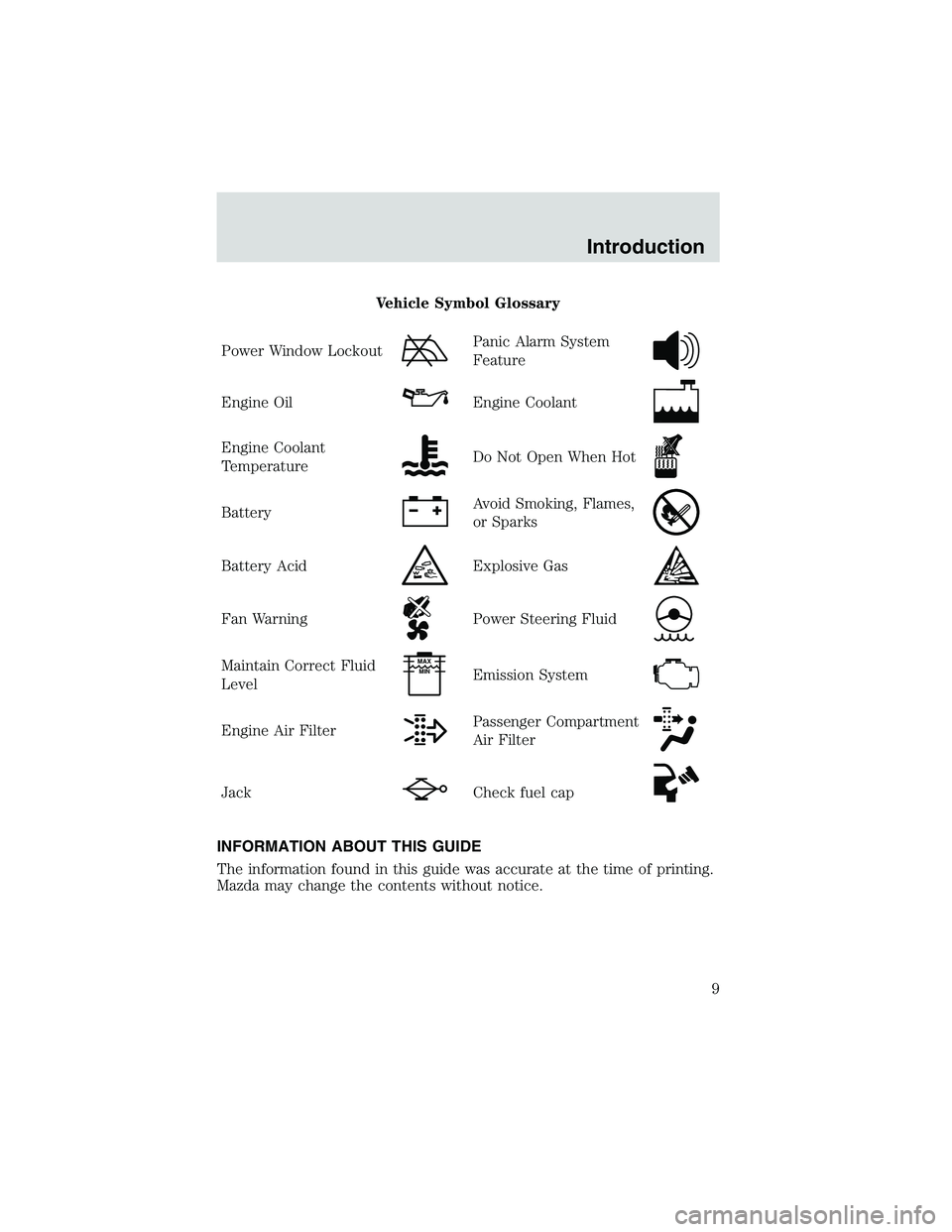
Vehicle Symbol Glossary
Power Window Lockout
Panic Alarm System
Feature
Engine OilEngine Coolant
Engine Coolant
TemperatureDo Not Open When Hot
BatteryAvoid Smoking, Flames,
or Sparks
Battery AcidExplosive Gas
Fan WarningPower Steering Fluid
Maintain Correct Fluid
LevelMAX MIN
Emission System
Engine Air FilterPassenger Compartment
Air Filter
JackCheck fuel cap
INFORMATION ABOUT THIS GUIDE
The information found in this guide was accurate at the time of printing.
Mazda may change the contents without notice.
Introduction
9
Page 19 of 288
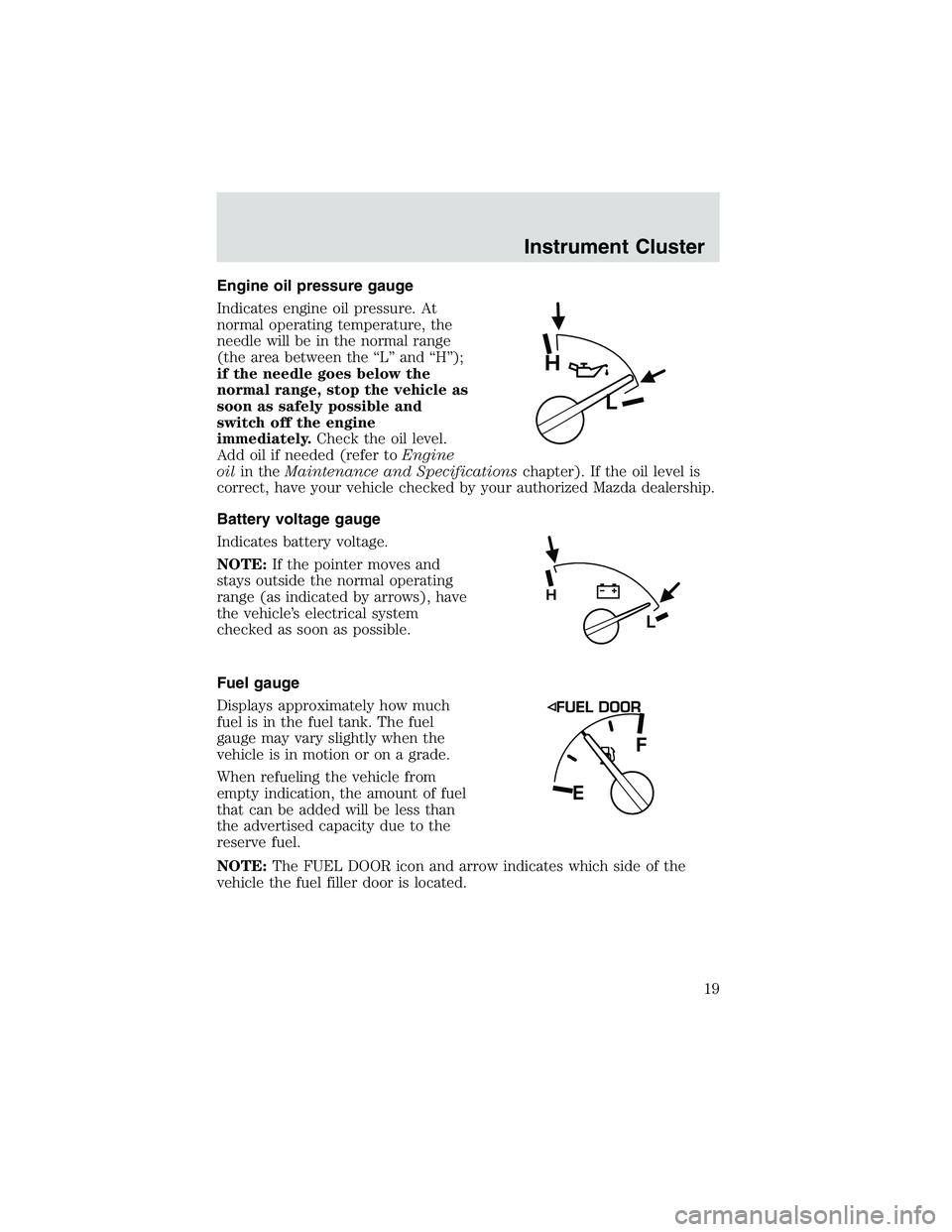
Engine oil pressure gauge
Indicates engine oil pressure. At
normal operating temperature, the
needle will be in the normal range
(the area between the “L” and “H”);
if the needle goes below the
normal range, stop the vehicle as
soon as safely possible and
switch off the engine
immediately.Check the oil level.
Add oil if needed (refer to Engine
oil in the Maintenance and Specifications chapter). If the oil level is
correct, have your vehicle checked by your authorized Mazda dealership.
Battery voltage gauge
Indicates battery voltage.
NOTE: If the pointer moves and
stays outside the normal operating
range (as indicated by arrows), have
the vehicle’s electrical system
checked as soon as possible.
Fuel gauge
Displays approximately how much
fuel is in the fuel tank. The fuel
gauge may vary slightly when the
vehicle is in motion or on a grade.
When refueling the vehicle from
empty indication, the amount of fuel
that can be added will be less than
the advertised capacity due to the
reserve fuel.
NOTE: The FUEL DOOR icon and arrow indicates which side of the
vehicle the fuel filler door is located.
H
L
L
H
Instrument Cluster
19
Page 225 of 288
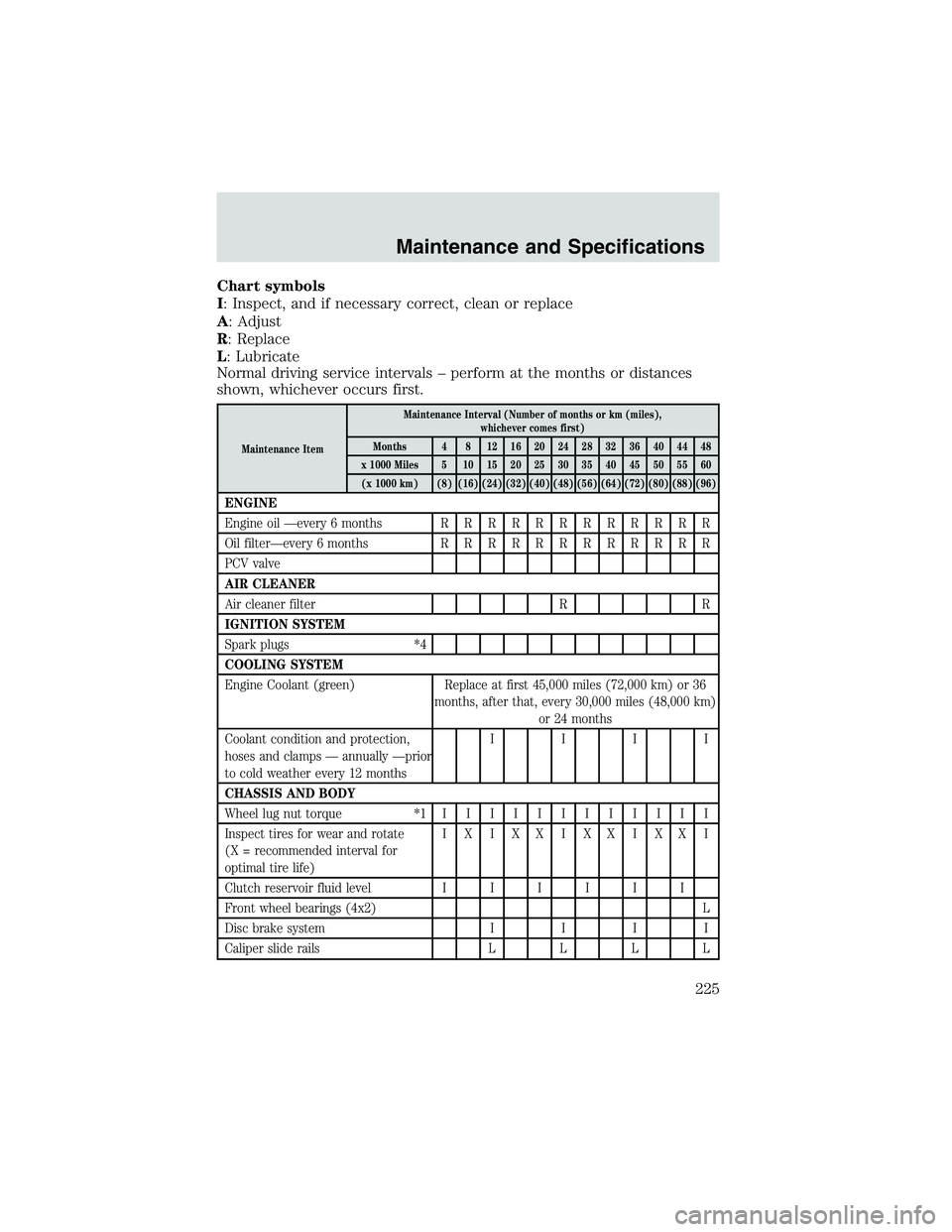
Chart symbols
I: Inspect, and if necessary correct, clean or replace
A: Adjust
R: Replace
L: Lubricate
Normal driving service intervals – perform at the months or distances
shown, whichever occurs first.
Maintenance ItemMaintenance Interval (Number of months or km (miles),
whichever comes first)
Months 4 8 12 16 20 24 28 32 36 40 44 48
x 1000 Miles 5 10 15 20 25 30 35 40 45 50 55 60 (x 1000 km) (8) (16) (24) (32) (40) (48) (56) (64) (72) (80) (88) (96)
ENGINE
Engine oil —every 6 months RRRRRRRRRRRR
Oil filter—every 6 months RRRRRRRRRRRR
PCV valve
AIR CLEANER
Air cleaner filter RR
IGNITION SYSTEM
Spark plugs *4
COOLING SYSTEM
Engine Coolant (green) Replace at first 45,000 miles (72,000 km) or 36
months, after that, every 30,000 miles (48,000 km) or 24 months
Coolant condition and protection,
hoses and clamps — annually —prior
to cold weather every 12 months IIII
CHASSIS AND BODY
Wheel lug nut torque *1IIIIIIIIIIII
Inspect tires for wear and rotate
(X = recommended interval for
optimal tire life) IXIXXIXXIXXI
Clutch reservoir fluid level IIIIII
Front wheel bearings (4x2) L
Disc brake system IIII
Caliper slide rails LLLL
Maintenance and Specifications
225
Page 227 of 288

5. The California Air Resources Board has determined that the failureto perform this maintenance item will not nullify the emission
warranty nor limit recall liability prior to completion of the vehicle’s
useful life.
Maintenance Item Maintenance Interval (Number of months or Miles (km),
whichever comes first)
Months 52 56 60 64 68 72 76 80 84 88 92 96
x 1000 Miles 65 70 75 80 85 90 95 100 105 110 115 120 (x 1000 km) (104) (112) (121) (128) (136) (144) (152) (160) (168) (176) (184) (192)
ENGINE
Engine oil —every 6 months RRRRRRRRRRRR
Oil filter—every 6 months RRRRRRRRRRRR
PCV valve R
AIR CLEANER
Air cleaner filter RR
IGNITION SYSTEM
Spark plugs *4 R
COOLING SYSTEM
Engine Coolant (green) Replace at first 45,000 miles (72,000 km) or 36 months, after that, every 30,000 miles (48,000 km) or 24 months
Coolant condition and
protection, hoses and clamps
— annually —prior to cold
weather every 12 months IIII
CHASSIS AND BODY
Wheel lug nut
torque *1IIIIIIIIIIII
Inspect tires for wear and
rotate (X = recommended
interval for optimal tire life) XXIXXIXXIXXI
Clutch reservoir fluid level IIIIII
Front wheel bearings (4x2) L
Disc brake system IIII
Caliper slide rails LLLL
Drum brake system, lines and
hoses IIII
Maintenance and Specifications
227
Page 231 of 288
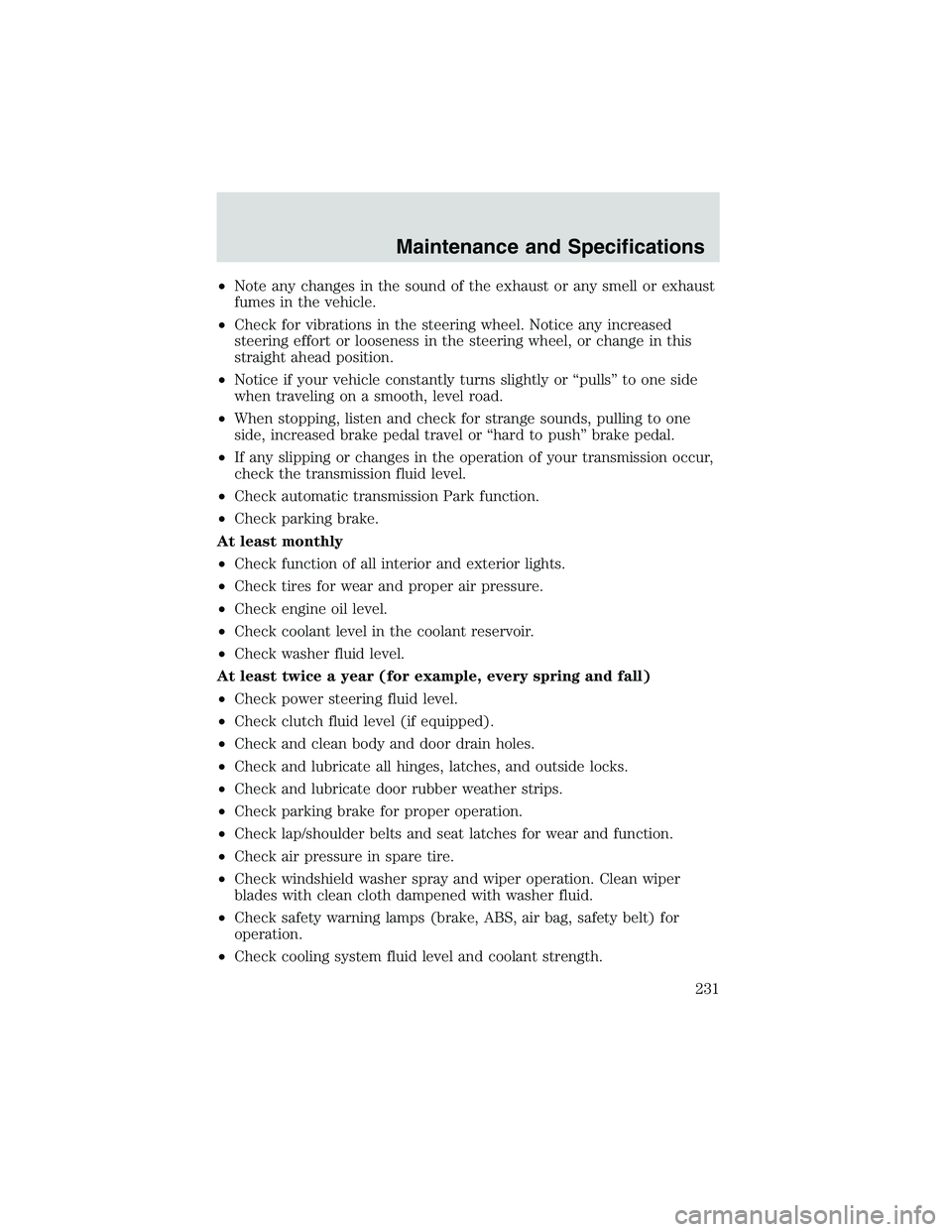
•Note any changes in the sound of the exhaust or any smell or exhaust
fumes in the vehicle.
• Check for vibrations in the steering wheel. Notice any increased
steering effort or looseness in the steering wheel, or change in this
straight ahead position.
• Notice if your vehicle constantly turns slightly or “pulls” to one side
when traveling on a smooth, level road.
• When stopping, listen and check for strange sounds, pulling to one
side, increased brake pedal travel or “hard to push” brake pedal.
• If any slipping or changes in the operation of your transmission occur,
check the transmission fluid level.
• Check automatic transmission Park function.
• Check parking brake.
At least monthly
• Check function of all interior and exterior lights.
• Check tires for wear and proper air pressure.
• Check engine oil level.
• Check coolant level in the coolant reservoir.
• Check washer fluid level.
At least twice a year (for example, every spring and fall)
• Check power steering fluid level.
• Check clutch fluid level (if equipped).
• Check and clean body and door drain holes.
• Check and lubricate all hinges, latches, and outside locks.
• Check and lubricate door rubber weather strips.
• Check parking brake for proper operation.
• Check lap/shoulder belts and seat latches for wear and function.
• Check air pressure in spare tire.
• Check windshield washer spray and wiper operation. Clean wiper
blades with clean cloth dampened with washer fluid.
• Check safety warning lamps (brake, ABS, air bag, safety belt) for
operation.
• Check cooling system fluid level and coolant strength.
Maintenance and Specifications
231
Page 238 of 288
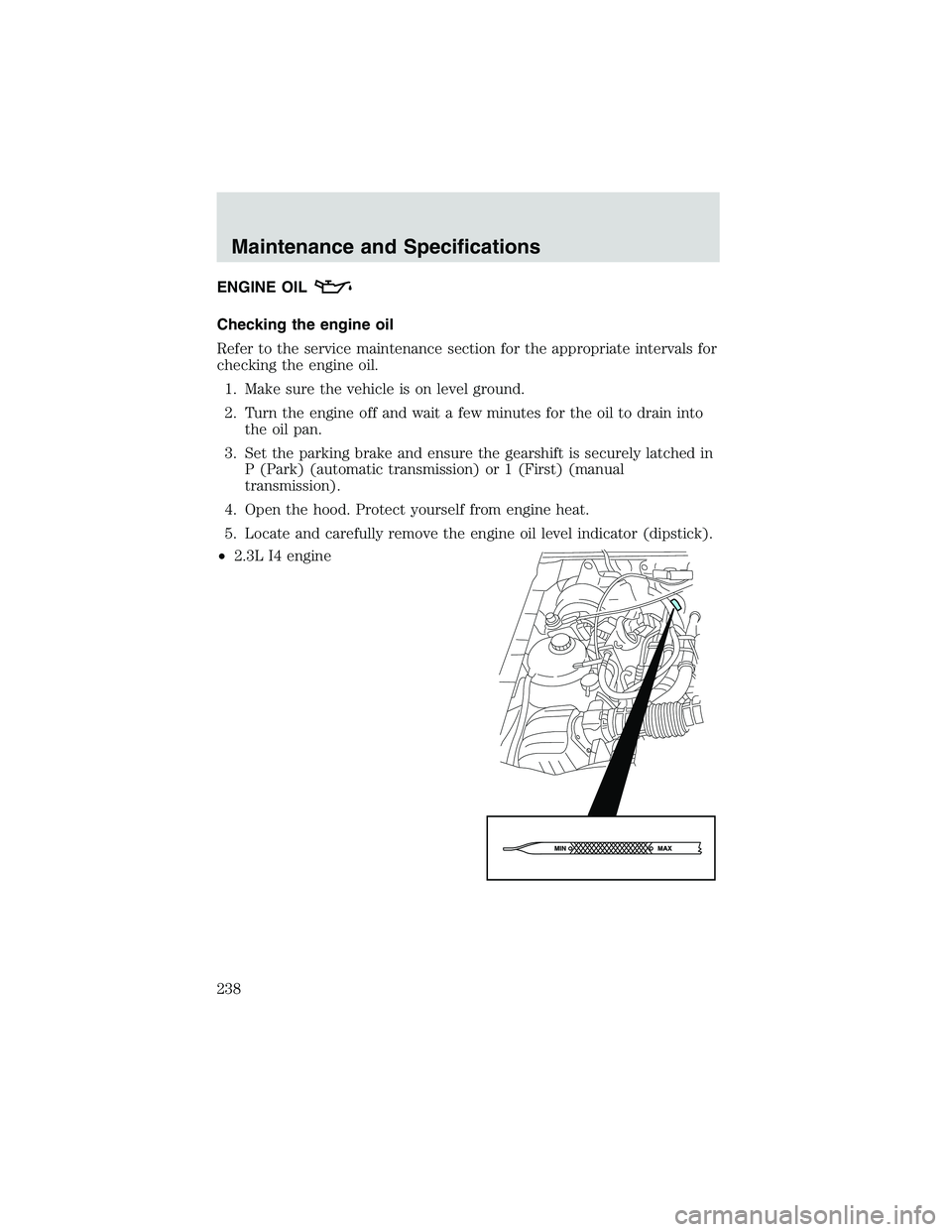
ENGINE OIL
Checking the engine oil
Refer to the service maintenance section for the appropriate intervals for
checking the engine oil.1. Make sure the vehicle is on level ground.
2. Turn the engine off and wait a few minutes for the oil to drain into the oil pan.
3. Set the parking brake and ensure the gearshift is securely latched in P (Park) (automatic transmission) or 1 (First) (manual
transmission).
4. Open the hood. Protect yourself from engine heat.
5. Locate and carefully remove the engine oil level indicator (dipstick).
• 2.3L I4 engine
Maintenance and Specifications
238
Page 240 of 288

6. Wipe the indicator clean. Insert the indicator fully, then remove itagain.
• If the oil level is between the MIN and MAX marks, the oil level is
acceptable, DO NOT ADD OIL.
• If the oil level is below the MIN mark, add enough oil to raise the level
within the MIN-MAX range.
• 2.3L I4 engine
• 3.0L V6 engine
Maintenance and Specifications
240
Page 241 of 288
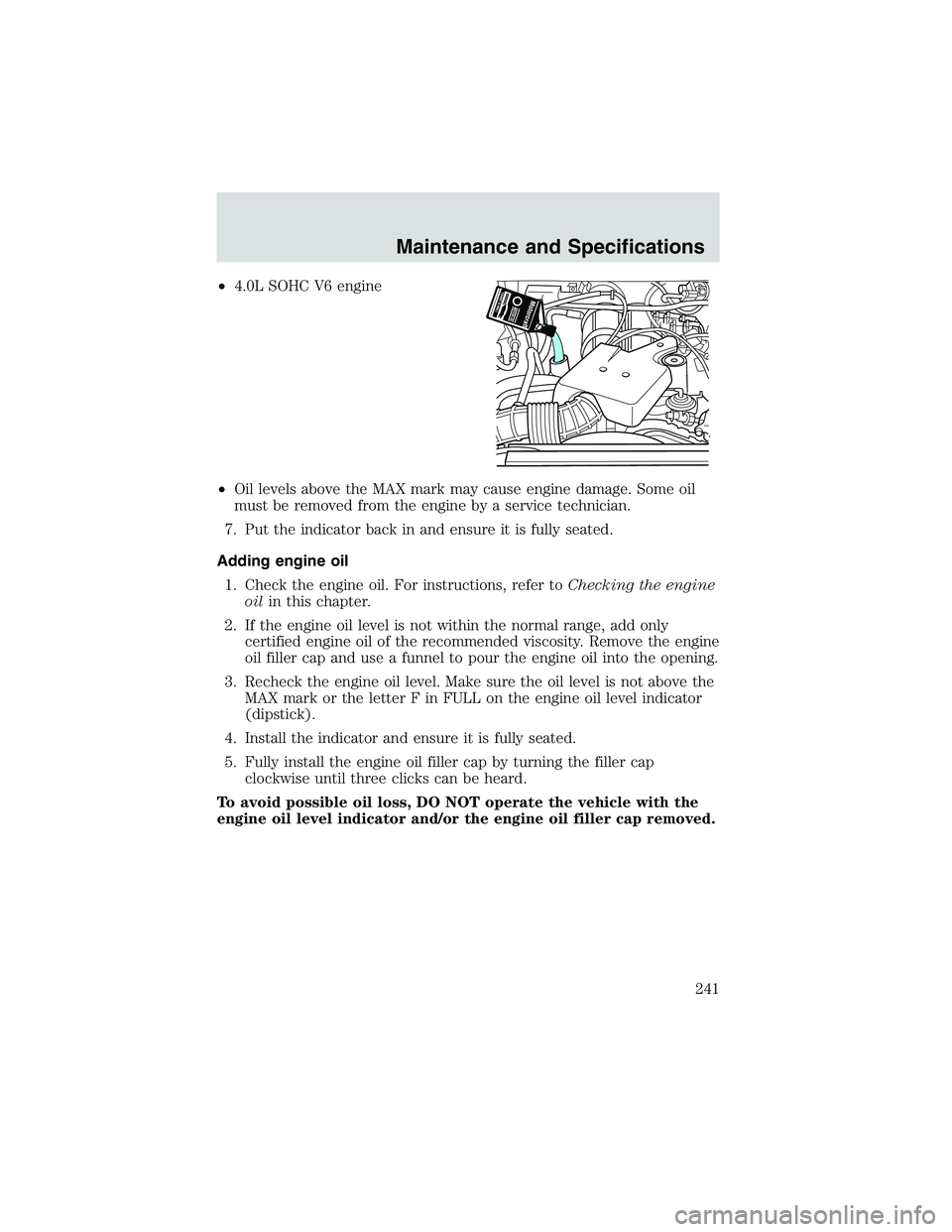
•4.0L SOHC V6 engine
• Oil levels above the MAX mark may cause engine damage. Some oil
must be removed from the engine by a service technician.
7. Put the indicator back in and ensure it is fully seated.
Adding engine oil 1. Check the engine oil. For instructions, refer to Checking the engine
oil in this chapter.
2. If the engine oil level is not within the normal range, add only certified engine oil of the recommended viscosity. Remove the engine
oil filler cap and use a funnel to pour the engine oil into the opening.
3. Recheck the engine oil level. Make sure the oil level is not above the MAX mark or the letter F in FULL on the engine oil level indicator
(dipstick).
4. Install the indicator and ensure it is fully seated.
5. Fully install the engine oil filler cap by turning the filler cap clockwise until three clicks can be heard.
To avoid possible oil loss, DO NOT operate the vehicle with the
engine oil level indicator and/or the engine oil filler cap removed.
Maintenance and Specifications
241
Page 243 of 288
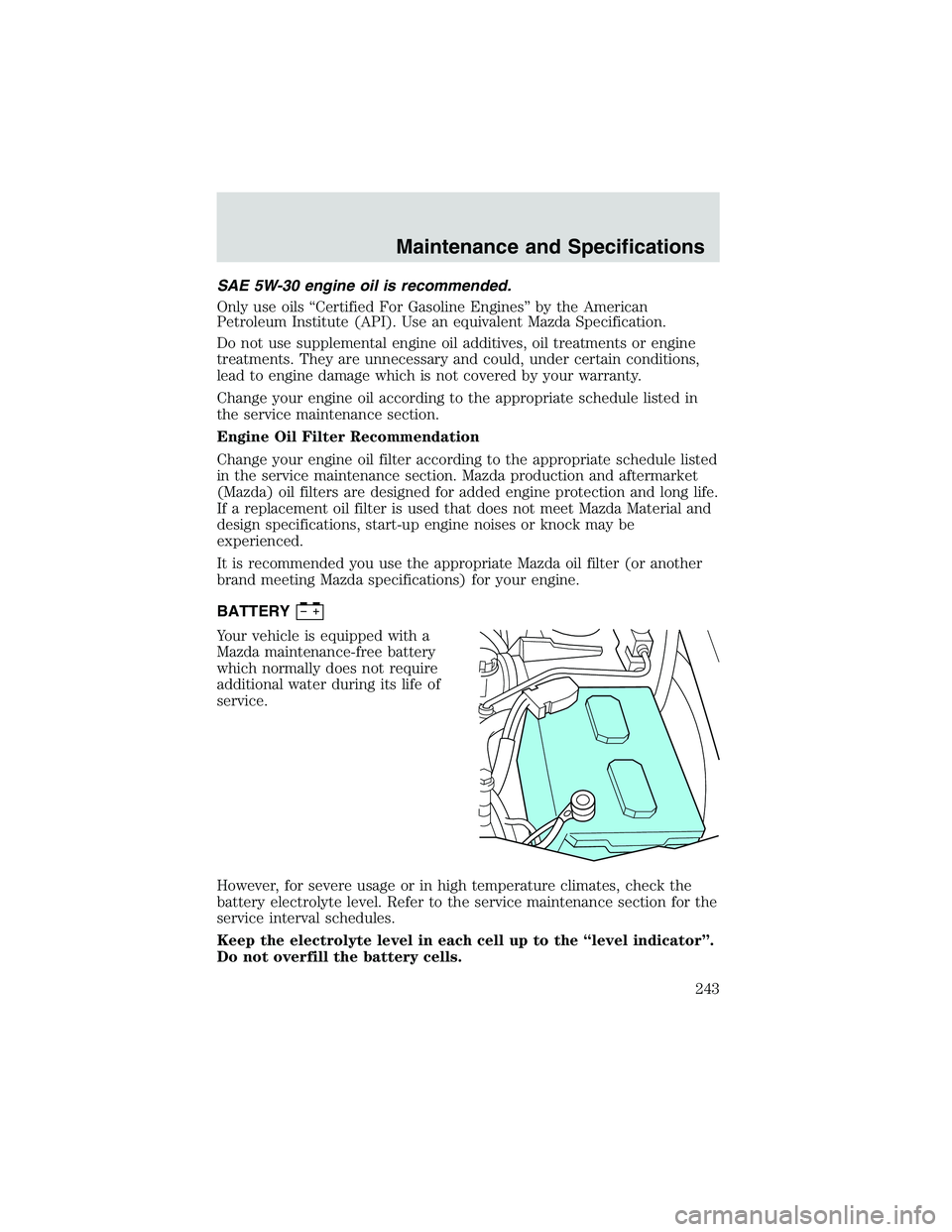
SAE 5W-30 engine oil is recommended.
Only use oils “Certified For Gasoline Engines” by the American
Petroleum Institute (API). Use an equivalent Mazda Specification.
Do not use supplemental engine oil additives, oil treatments or engine
treatments. They are unnecessary and could, under certain conditions,
lead to engine damage which is not covered by your warranty.
Change your engine oil according to the appropriate schedule listed in
the service maintenance section.
Engine Oil Filter Recommendation
Change your engine oil filter according to the appropriate schedule listed
in the service maintenance section. Mazda production and aftermarket
(Mazda) oil filters are designed for added engine protection and long life.
If a replacement oil filter is used that does not meet Mazda Material and
design specifications, start-up engine noises or knock may be
experienced.
It is recommended you use the appropriate Mazda oil filter (or another
brand meeting Mazda specifications) for your engine.
BATTERY
Your vehicle is equipped with a
Mazda maintenance-free battery
which normally does not require
additional water during its life of
service.
However, for severe usage or in high temperature climates, check the
battery electrolyte level. Refer to the service maintenance section for the
service interval schedules.
Keep the electrolyte level in each cell up to the “level indicator”.
Do not overfill the battery cells.
Maintenance and Specifications
243
Page 246 of 288
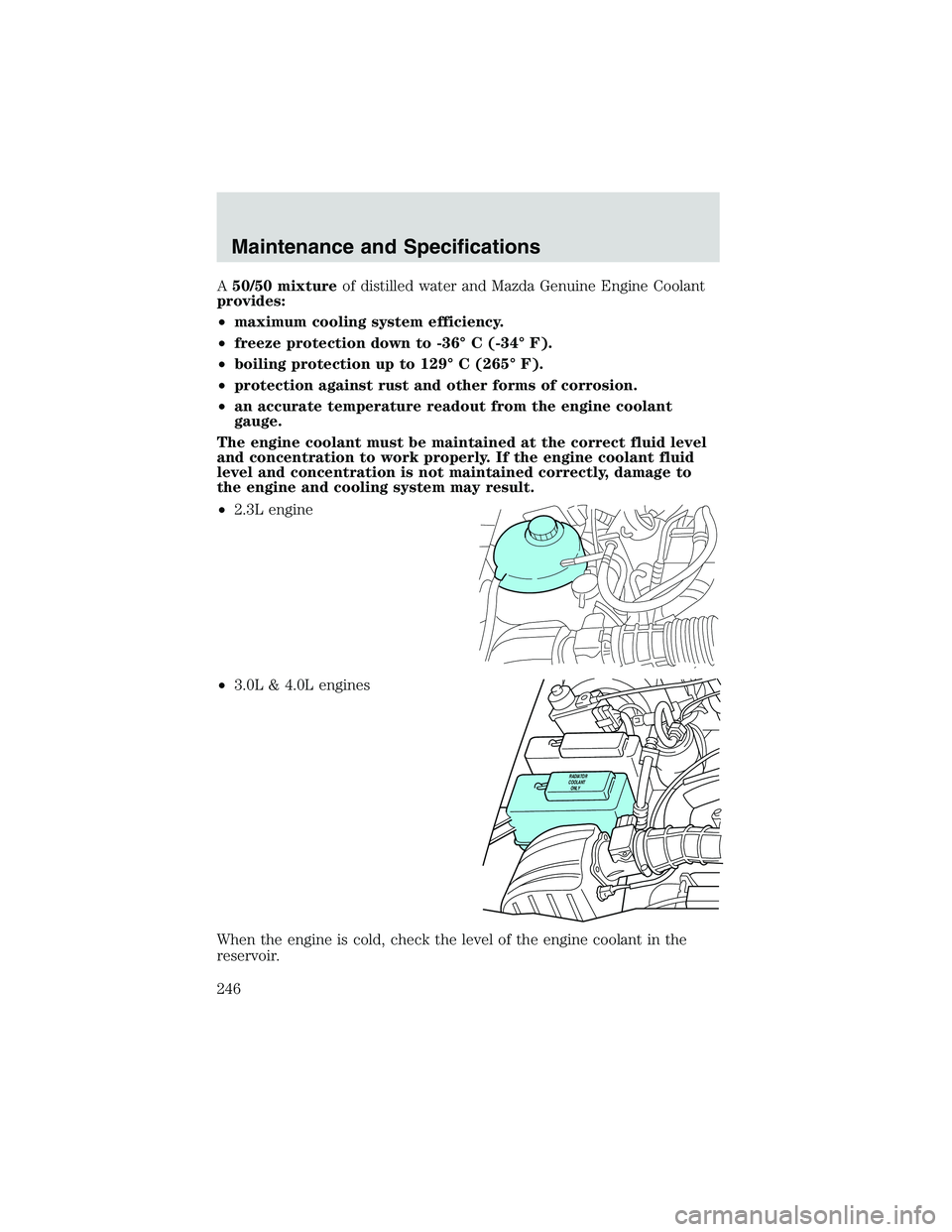
A50/50 mixture of distilled water and Mazda Genuine Engine Coolant
provides:
• maximum cooling system efficiency.
• freeze protection down to -36° C (-34° F).
• boiling protection up to 129° C (265° F).
• protection against rust and other forms of corrosion.
• an accurate temperature readout from the engine coolant
gauge.
The engine coolant must be maintained at the correct fluid level
and concentration to work properly. If the engine coolant fluid
level and concentration is not maintained correctly, damage to
the engine and cooling system may result.
• 2.3L engine
• 3.0L & 4.0L engines
When the engine is cold, check the level of the engine coolant in the
reservoir.
RADIATOR COOLANT ONLY
Maintenance and Specifications
246